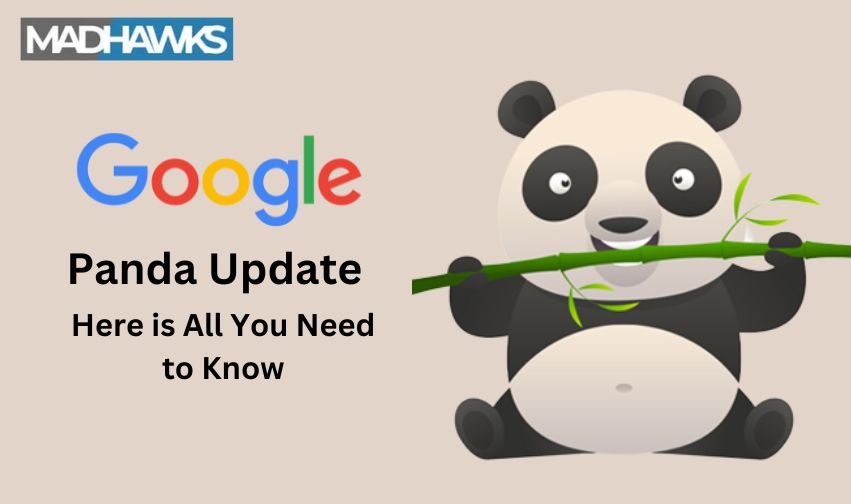In February 2011, Google released the Panda algorithm in SEO. Here is all that you need to know about the Panda update.
For enhanced and professional SEO services, Google has been updating and making necessary changes to its algorithms, while also releasing new updates. From the day Google was officially introduced, the journey to provide affordable SEO services has been involved with new strategies and updates. Here we are going to have a look at Google’s Panda update.You can also read Panda & Other updates in our most important blog 25 unforgettable updates on completion of Google 25 years.
What is Panda Update?
The Google Panda update was released in February 2011 with the main objective of reducing black hat SEO tactics and webcams. The Panda algorithm in SEO was released to reward websites with high-quality content demote low-quality websites and offer the user with better search experience.
However, one interesting fact about this Panda update is that initially this update was named as ‘Farmer’, and during the initial phase of the Panda algorithm being rolled out, approximately 12% of websites in English were affected and lost their rankings in search results.
After the release of the Panda update, in an official statement, it was said that “This update is designed to reduce rankings for low-quality sites – sites which are low-value add for users, copy content from other websites or sites that are just not very useful. At the same time, it will provide better rankings for high-quality sites – sites with original content and information such as research, in-depth reports, thoughtful analysis and so on.”
Why was the Google Panda update released?
During the launch of the Panda Google algorithm, Google said that the Panda update was released keeping under consideration the increase in ‘content farm’ and low quality of search results.
Additionally, Google’s Amit Sehgal said in an interview that the ‘caffeine’ update of 2009 which for a certain period of time was working efficiently and provided a boost to the search results by speeding up the indexing process also indexed some not-so-good or up to the mark websites.
The above-mentioned reasons were the main force behind launching the Panda algorithm for better SEO services and approach. Furthermore, here are a few more points that triggered the release of the Panda algorithm in SEO.
- Duplicate content
Websites that were found having duplicate content and were creating confusion in the search results. The duplicate content being shown in the search result which had little or no variations on multiple pages.
- Thin content
Website pages with very less supportive or related content and lacking detailed information about the content or data on the website.
- Low-quality content
Web pages with low quality of content that is not relevant to the user search query and doesn’t contain any substantial content that is related to the search.
- Content farming
This is when a large number of web pages with similar low-quality content are accumulated together.
- Lack of authoritative content
Content without any suitable and reliable sources and relevant information.
- Low-quality UGC
Web pages publishing guest content with lots of grammatical errors and other mistakes.
- Ad-to-content ratio
Web pages with a large number of ads on the pages compared to the content available on the pages.
- User blocked websites
Websites that have been marked as spam or blocked by the users.
- Content and search mismatch query
User search query and the webpage content mismatch, and the relevance is shown by adding one or two relevant keywords.
Additionally, once the Panda algorithm in SEO was released, it affected a large number of websites that consisted of any of the above-mentioned issues and hence, lost their ranking as well.
Affected by the Panda update?
Once the panda update was released a large number of websites were affected and in the initial stages English language websites took a major hit. Furthermore, if your website was hit by the Panda google algorithm or was it just a regular fluctuation, how would you know the difference?
Here are a few points that worked as indicators if your website was hit by the panda algorithm in SEO.
- Sudden drop in website’s organic traffic
- Reduced search engine ranking
- Check the indexing of your website
- Is the whole website indexed or just the homepage
- Is your website still ranking on the brand name or any other unique name
- Search the relevant keyword in your page title and look for the top 10-20 results
If you still cannot find your website then you definitely have been hit by the Panda update and the recommendation is to get some high-quality web content on your page and improve the SEO of your webpage.
Recovering from Panda update
Now that you know that your website is hit by the Panda algorithm in SEO, here are a few points for you to try to recover from this hit.
- Improve the content quality on your webpage
- Give up content farming practices
- Remove duplicate content
- Provide more relevant and detailed information on the page
- Incorporate error-free UGC (user-generated content)
What do the MadHawks have to say about the Panda update?
Being a digital marketing agency, MadHawks never promotes the use of such black hat content or SEO strategies to get your page up in the ranking. Instead our highly professional team works best to help you get organic traffic and generate genuine content for your website.
All these practices allow us to keep the websites unaffected at a larger scale due to such updates being released. For more information get in touch with our expert SEO team today.
FAQ
What was the main purpose of Panda update?
The main purpose of the Panda update is to reduce the black hat SEO and content farming strategies and promote high-quality content.
When did the Panda update happen?
Panda update was released in February 2011, however, several updates in the Panda algorithm were introduced throughout the time.
What is the difference between Penguin and Panda update?
Panda update targets the low-quality content whereas Penguin update targets the spammy content.
What are the Myths of Panda Update?
- Panda doesn’t target duplicate content
- Deleting content can resolve Panda affects
- Panda doesn’t target UGC
- Word count doesn’t matter in panda update
How to Recover your website from Panda?
- Remove duplicate content
- Reduce thin content
- Add more trustworthy content
- Add high-quality content







